Image credit: SIGGRAPH Conferences
In January, the Lunar New Year welcomed the Year of the Rabbit. The rabbit is a symbol of longevity, peace, and prosperity. It’s also a popular figure in the world of SIGGRAPH conferences thanks to the Stanford Bunny model. As SIGGRAPH 2023 prepares to celebrate its 50th conference this August in Los Angeles, we connected with SIGGRAPH Asia 2023 Conference Chair June Kim to hear more about how the Year of the Rabbit relates to SIGGRAPH conferences, both in North America and Asia, and the prosperous future they create for the computer graphics industry.
SIGGRAPH: This year is the Year of the Rabbit. What does the Rabbit symbolize in Chinese culture?
June Kim (JK): In Asian culture, rabbits symbolize prosperity, longevity, peace, and wisdom. Also, rabbits are among the more commonly featured characters in folktales and literature in Asian culture, along with a tiger. They are often presented as a creature of wisdom, wit, and agility.
SIGGRAPH: Longevity is a pillar of the Rabbit. It’s fitting that the SIGGRAPH North American conference is celebrating its 50th annual event this year. How does the spirit of the Year of the Rabbit relate to the purpose and thought leadership behind the SIGGRAPH conferences — both in North America and Asia?
JK: The spirit of the Year of the Rabbit with longevity, agility, and innovation closely aligns with the purpose and thought leadership behind the SIGGRAPH and SIGGRAPH Asia conferences. Since 1974, SIGGRAPH — and SIGGRAPH Asia since 2009 — meetings have always been in the limelight of technological innovation and have played a vital role in leading the development of computer graphics and interactive techniques. The Year of the Rabbit characteristics are well reflected in SIGGRAPH’s commitment to thriving through its emphasis on continuing education, research, mentorship, collaboration, and success in computer graphics and interactive techniques.
SIGGRAPH: Speaking of longevity, the Stanford Bunny is a popular computer graphics model referenced in many SIGGRAPH contributions over the years. What made this model so revolutionary that today’s computer graphics professionals continue to reference it nearly 30 years after its discovery?
JK: In the 1990s, finding great 3D models was difficult, and most models were created by hand. The Stanford Bunny, which Marc Levoy and Greg Turk scanned, is the world’s first 3D computer model of a complex object using a laser scanner. The details of the mesh of this “garden-variety object” were outstanding. The model is a mesh and is quite complex, with no texture attached. Therefore, it has inspired many to use it for solving various research problems, such as lighting, texturing, deformation, and more. The Stanford Bunny has achieved an iconic status in the computer graphics community and is extensively employed for research and teaching today. Its longevity is not only proof of a high-quality tool for the computer graphics field but overlaps with rabbits’ symbolic character in Asian culture.
SIGGRAPH: Over the years, we have seen some clever renderings of the Stanford Bunny, like “melting into sand,” etc. What is your favorite execution/rendering using the Stanford Bunny?
JK: I cannot even count how many times I was astonished and laughed out loud seeing the Stanford Bunny simulations in the Technical Papers Fast Forward sessions. Instead of selecting one of the best or my favorite from all the most outstanding work, I would like to introduce my experiment with Stanford Bunny simulation interacting with breath input and gesture as a part of my interactive mirroring project.
SIGGRAPH: What do you think the Year of the Rabbit holds for us this year for SIGGRAPH conferences and those who celebrate?
JK: This year’s theme for SIGGRAPH Asia is Connecting Stories. As I introduced above, rabbits are among the most featured characters in Asian folktales. In some way, this legacy is continued in the history of computer graphics as being the most used reference! Bring the story with a rabbit in your heart, and we will build a remarkable time together to share and connect our rabbits. The traits of creativity and ingenuity associated with the rabbit could inspire you to explore new ideas and push the boundaries of computer graphics and interactive techniques.
No matter what your story is this year, we hope it involves SIGGRAPH. Register now for SIGGRAPH 2023, taking place 6–10 August in Los Angeles. Interested in SIGGRAPH Asia 2023? The SIGGRAPH Asia 2023 call for submissions is now open. Find out more about submissions and the conference, taking place 12–15 December in Sydney, Australia.

June Kim is the SIGGRAPH Asia 2023 Conference Chair. She has an educational background in creative technologies, multimedia, and IT/commerce. She is an associate lecturer (immersive design), UNSW Sydney. Prior to joining academia, she worked as a compositor and digital designer in New Zealand for about a decade. Since her first service as a Student Volunteer at SIGGRAPH Asia 2010, she has been participating in SIGGRAPH and SIGGRAPH Asia conferences as a reviewer, juror, and on the conference committee.



